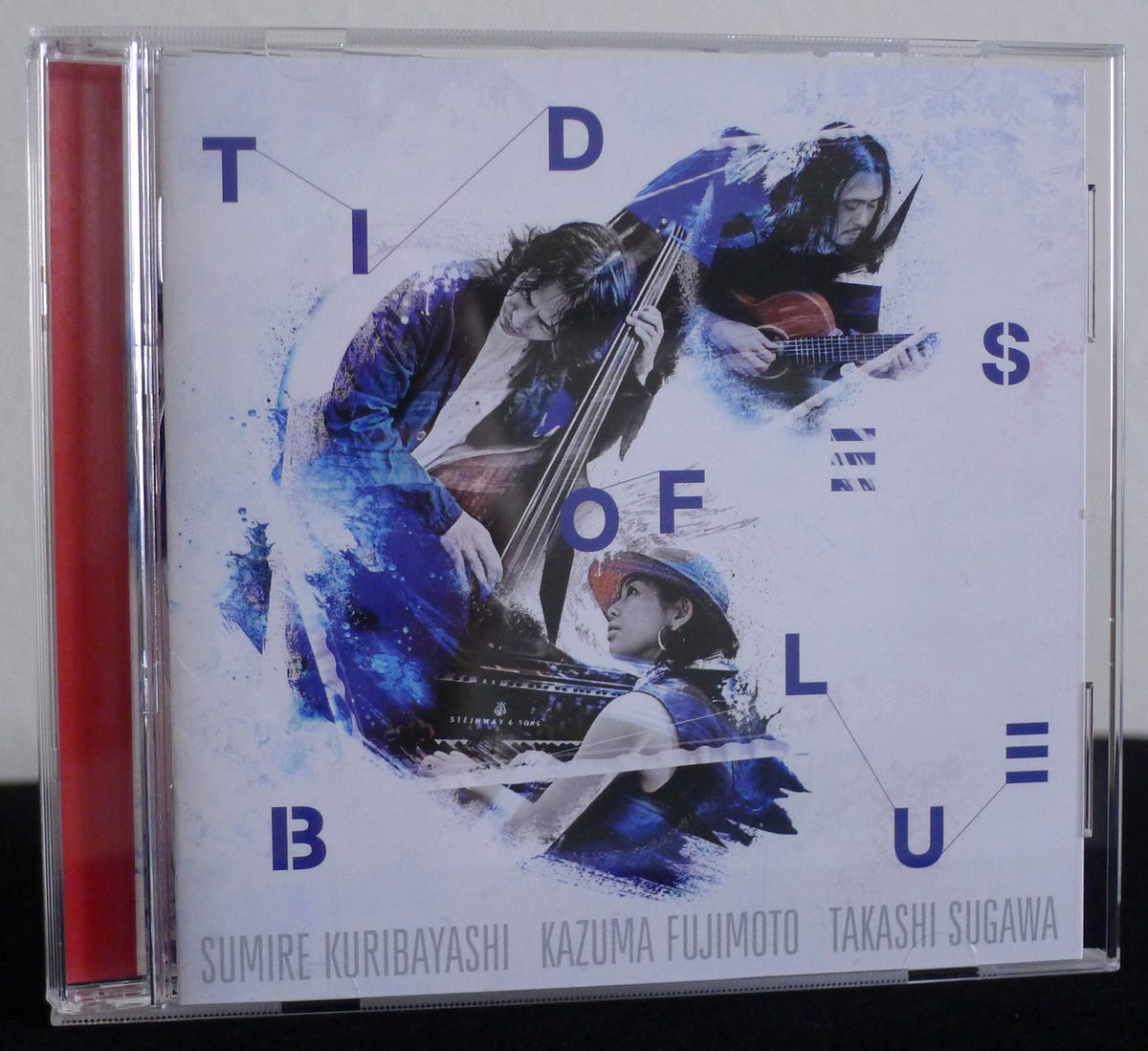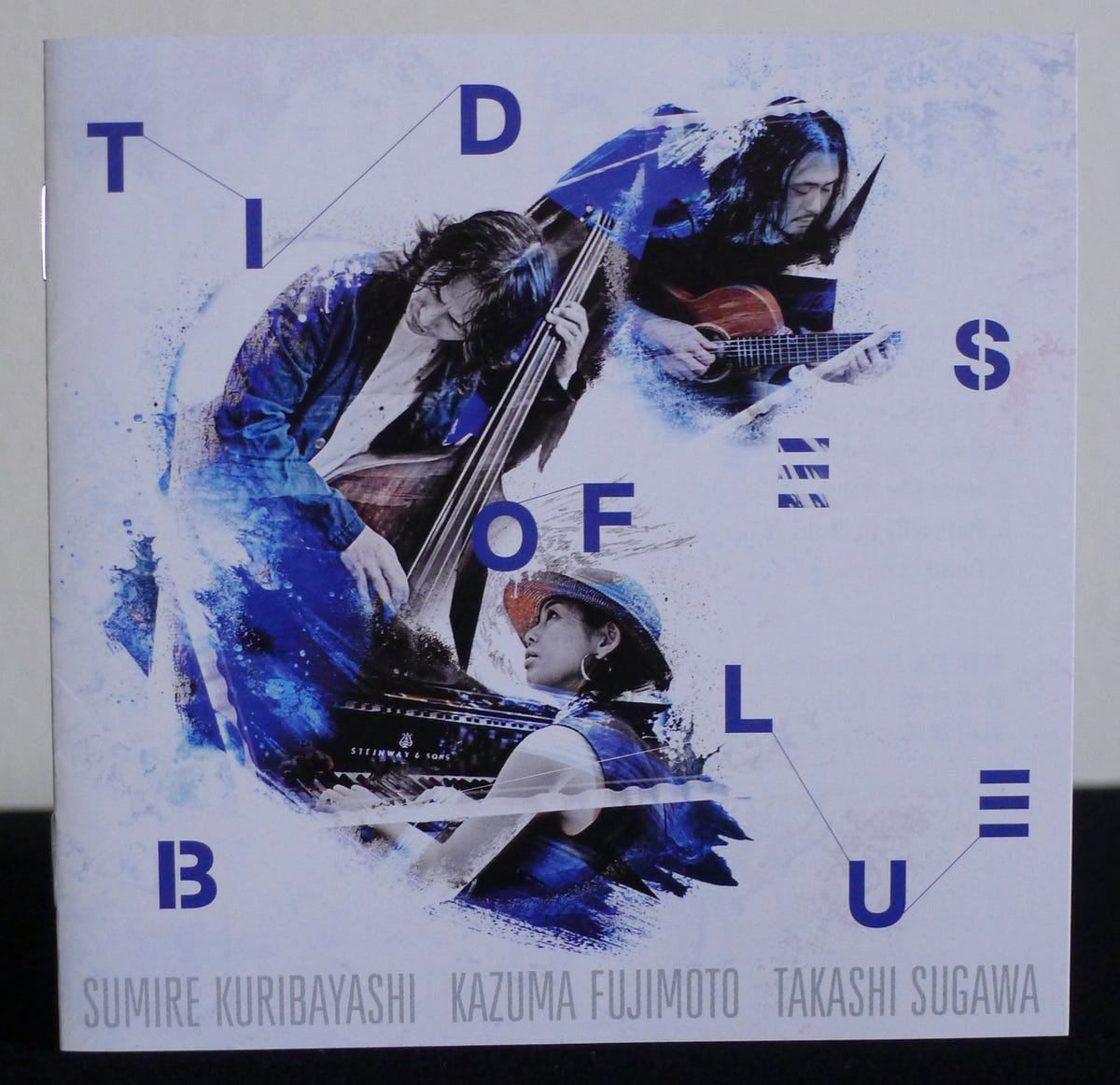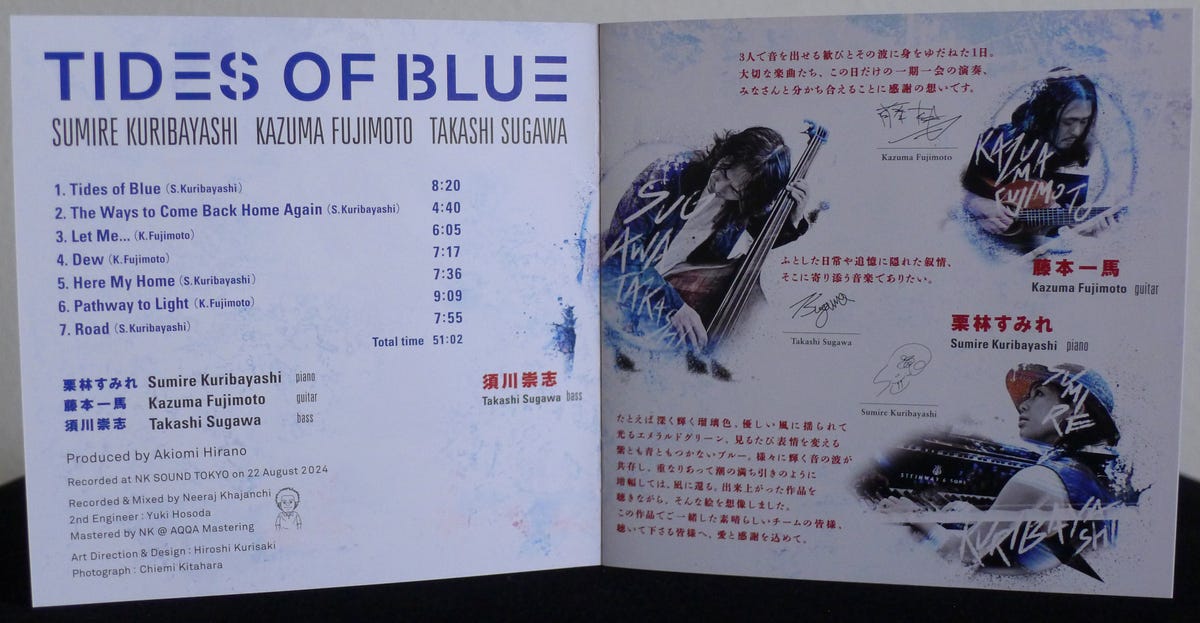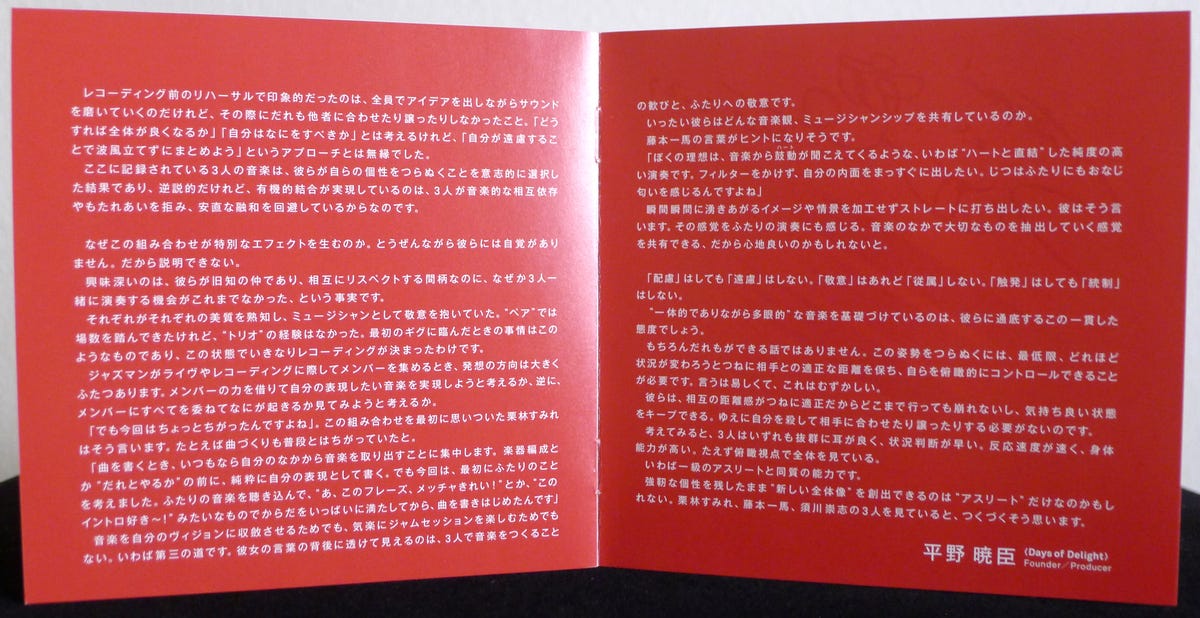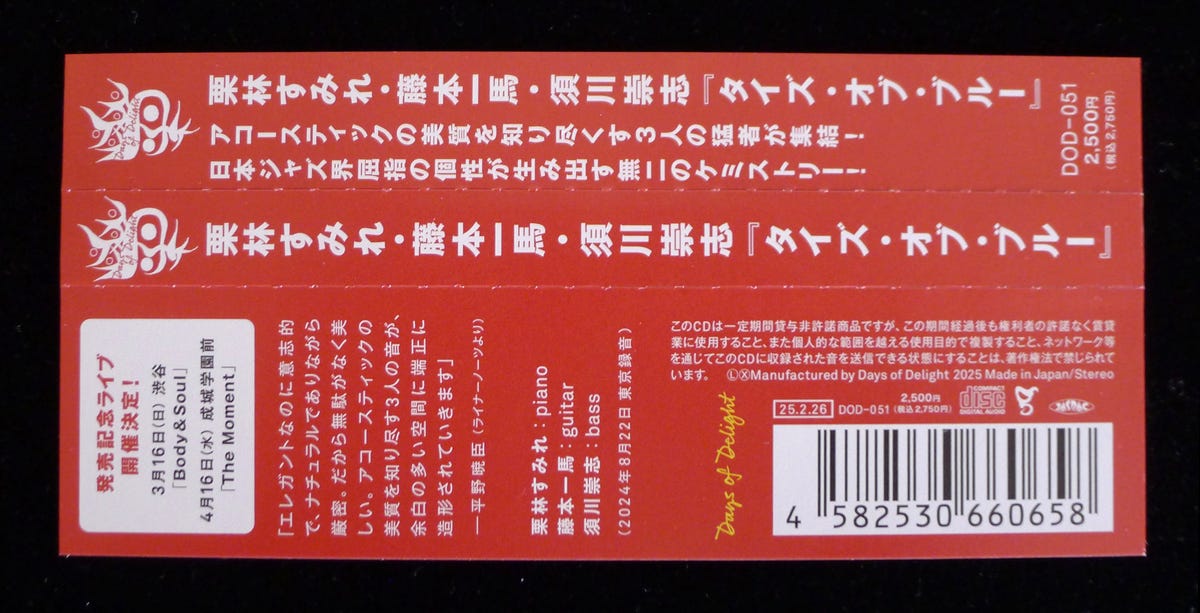Sumire Kuribayashi / Kazuma Fujimoto / Takashi Sugawa: Tides of Blue
Tides of Blue is a 2025 release from the collaboration of Japanese jazz musicians Sumire Kuribayashi, Kazuma Fujimoto, and Takashi Sugawa on piano, guitar, and bass, respectively. On this album, the trio plays seven new songs, four composed by Kuribayashi and three by Fujimoto, for a total play time of 51 minutes.
The album brims with brilliant acoustic music full of clear harmonies and patiently developed melodies. The music reflects abstract themes represented by words in the song titles like movement (ways, roads), water (blue, dew, tides), and belonging and comfort (home, let me). The music is not abstract, however, but pinned down with the strength of conviction and personality that each player brings to the music. Each’s player’s identity does not dissolve in the trio but combines to create a new sound that is the sum of the parts. While there is, at first brush, a seemingly slow-moving surface that may describe meditative music as with a yoga playlist or a quiet church setting, there is an undertow of jazz, pop, blues, classical, free, and folk influences throughout. (It’s may be a high bar, but as a sound reference, think of concepts like Keith Jarrett’s Koln Concert…). There is depth and nuance in the confident calm, in the ebb and flow. Quietness and patience allow for the trio’s delicate touches to be more noticable and emotionally powerful. It’s not overwhelming, not sparse, but comfortingly present, familiar, pervasive.
Liner Notes
(Translated from Akiomi Hirano’s original Japanese liner notes.)
A day spent surrendering ourselves to making music as a trio. We are grateful to be able to share this one-day, once-only performance with you.
Kazuma Fujimoto
I wish for the music to accompany the subtle lyricism hidden in fleeting everyday moments and memories.
Takashi Sugawa
For example, a deep shining ultramarine, a glittering emerald green swaying in a gentle breeze, a violet or azure blue that changes expression with every glance. Waves of multiple sounds coexist and overlap and expand like tides before they return to being calm. I imagined such a scene while listening to the finished recording. With love and gratitude to the wonderful team who assisted with this project, and to everyone who is listening.
Sumire Kuribayashi
A divine combination
It can be described only as a divine combination.
It’s a happy moment particularly encountered in live jazz.
A phenomenon where a special sound emerges only by the combination of certain players, a matter of chemistry that can’t be predicted or planned in advance. Even when it does happen, it’s a delicate configuration where the magic could be lost if one member is absent or substituted with another musician.
Although the mechanism of creation may not be understood, it’s clear that it does not happen through top-down commands or orders. Rather, it’s the opposite of having too strong a direction. The basis is formed by equality and a mutually inspirational relationship between the members.
Strong personalities to inspire each performer, advanced skills to protect the music no matter what happens, creative ambition to expand individual musical potential… Perhaps only musicians who possess these three qualities meet the requirements for a divine combination.
However, assembling musicians who meet these requirements does not necessarily guarantee that the magic will happen. You won’t know unless you try, and the success rate is not very high. To put it plainly, it’s almost like winning the lottery, and not something that is created deliberately through intention.
I recently had the good fortune to witness this special unit, this divine combination. It was this drumless trio that I saw at Shibuya’s long-running jazz bar Body & Soul in June 2023.
I was very familiar with the three musicians, Sumire Kuribayashi, Kazuma Fujimoto, and Takashi Sugawa. But this was the first time I had seen them together. As it turned out, this wasn’t surprising, since this was their first gig together.
The music from these three musicians, filled with unique nuances, resembled nothing else I knew of. Without any hesitation, I proposed an offer to record them.
Following that, they played three gigs in preparation for the recording. With each one, they improved the precision of their sound and increased their level of sophistication even further.
Strong-willed yet elegant, natural yet meticulous. The result is that it’s beautiful without being cluttered.
These three know the virtues of acoustic music well, and their sound is gracefully shaped in an open space with lots of room for expression.
Their sound is worthy of special mention, as although it is tightly bound together for a cohesive sound as a mass feeling, each person’s individuality distinctly stands out as well. This unified yet multi-faceted aspect allows the sound of each to be heard clearly.
I wanted many jazz fans to be able to experience this irreplaceable sound. That was the wish that led me to produce this work.
Each of the three musicians works with their own bands made up of first-class musicians of different styles to expand the possibilities of expressing themselves.
Apart from her jazz influences, Sumire Kuribayashi was raised in a musically rich environment that included a koto master for a father, and she was blessed to hear a variety of music in her youth. While still young, she released her debut album in 2014, and after that she continued to release original records as a front-line pianist. What’s particularly noteworthy is that her traits and characteristics are unlike anyone else. Her individual style and underlying foundation are powerfully flexible yet unshakable.
Kazuma Fujimoto was also influenced by his father, who was a guitarist and singer-songwriter. He took up the guitar and formed the band Orange Pekoe in 1998. While gaining accolades for a unique sound that transforms diverse musical elements through his own interpretations, he is also active in the jazz scene and expanding his solo activities. Along with his radiant and beautiful personal tone, his lyrical and melodious original songs have also received high praise.
Takashi Sugawa has had close ties with Days of Delight starting with the recording of his band Banksia Trio. He is a renowned top bassist in the jazz world both in name and substance. He receives continuous requests to perform with musicians of all types, not only due to how he expands the band sound with his creative playing style, but also through the high-quality stimulation that his musical intelligence provides to his co-performers. To hear his sound is to immediately recognize it as his inherent texture.
The biggest effect of the sound that these three create is that it is not a simple sum or mathematical average, but an amalgamation of the whole into one body of mass. Figuratively speaking, it is more like a derived compound rather than building blocks.
However, this does not mean that their personalities are buried within the whole. As mentioned before, their individual identities are firmly noticeable. That is the crucial point.
While the three maintain their strong individuality (that is, each keeping their musical presence), they create a new overall picture. That is exactly the grounds for the truly divine combination that is a unique virtue of this band.
At the rehearsal before the recording, what impressed me was how everyone was refining their sound while sharing ideas without compromising themselves to match the others. Their thoughts were along the lines of “What should we do to make the group sound good,” and the approach of “Let’s constrain ourselves to avoid making waves” was not entertained.
The music recorded here by these three is the result of a conscious choice to preserve their individual personalities. It may be a paradox, but their organic connection is realized as the three reject musical interdependence and reliance and avoid easy harmony.
Why does this combination produce a special effect? Naturally, they have no awareness of it, so it cannot be explained.
It’s interesting that, despite the musicians being old friends who hold mutual respect for one another, for some reason, they didn’t have the opportunity to play together until now.
Each knows the other’s virtues and respects their musicianship. They had experiences as pairs [duos] but had none as a trio. These were the circumstances when I saw them on their first gig. This was the situation that sparked my sudden decision to record them.
When a jazz insider is gathering musicians for a live event or recording, there are two basic approaches. Should you channel the power of the musicians to express your desired musical vision? Or, conversely, should you leave everything up to the musicians and see what happens?
“But, this time it was a little different, you know.” This is how Sumire Kuribayashi described it, as she was the one who first considered this combination of players. For example, the songwriting process was different from usual.
“When I am songwriting, I always concentrate on bringing the music out of myself. Before thinking about the instrumentation or which musicians to partner with, I write to express myself purely. But this time, I was thinking of these two musicians from the start. Listening intently to their music, I had reactions like “Oh, this phrase is so pretty!” and “I like this intro!”, and I began to write songs filled with these ideas.
It’s not about shaping the music to one’s own vision, or about simply enjoying a carefree jam session. In other words, it is a third path. What can be discerned behind her words is the joy of making music as a trio and her respect for the other two members.
What types of musical perspective and musicianship do they have in common?
Kazuma Fujimoto’s words hint at this.
“My ideal is that the music lets you hear the heartbeat, that is, a heart-connected highly pure performance… to put out my inner self directly without any filters. In fact, I can sense this same characteristic in the other two musicians.”
He continues: Moment by moment, I want to express the scene and the images that arise without processing them. I also feel this with the other two. Perhaps it sounds good because they share the same feeling of what is important to extract from the music.
Consideration is a factor, but constraint is not. Respect, not submission. Inspiration, not control.
It must be this integrated position that the three share that is the basis of their unified yet multi-faceted music.
It’s not something that everyone can do, of course. At a minimum, preserving this attitude requires sustaining an appropriate distance from others while maintaining control of yourself, regardless of how much the situation changes. It’s easy to say, but difficult to accomplish.
This group constantly maintains the right distance from each other without breaking, so they can maintain a comfortable state no matter where they go. Therefore, there is no need to sacrifice themselves and yield to another in order to adapt to them.
Thinking about it, all three are gifted with exceptional hearing and can assess the situation quickly. Their reaction times are fast, and their physical abilities are excellent. They are always seeing everything from above. These are the same qualities that top athletes possess.
It may be that only athletes can create a new overall picture imbued with their strong individuality. When I see the trio of Sumire Kuribayashi, Kazuma Fujimoto, and Takashi Sugawa, I truly think so.
平野暁臣 Akiomi Hirano
(Days of Delight)
Founder/Producer
Obi Notes
Sumire Kuribayashi / Kazuma Fujimoto / Takashi Sugawa Tides of Blue
A gathering of three musicians who know the virtues of acoustic music well!
An unparalleled chemistry created by leading personalities in the Japanese jazz world!
“Strong-willed yet elegant, natural yet meticulous. The result is that it’s beautiful without being cluttered. These three know the virtues of acoustic music well, and their sound is gracefully shaped in an open space with lots of room for expression.” — Akiomi Hirano (from the liner notes)
Tides of Blue by Sumire Kuribayashi / Kazuma Fujimoto / Takashi Sugawa
Sumire Kuribayashi - piano
Kazuma Fujimoto - guitar
Takashi Sugawa - bass
Released in 2025 on Days of Delight as DOD-051.
Names in Japanese: 栗林すみれ Kuribayashi Sumire 藤本一馬 Fujimoto Kazuma 須川崇志 Sugawa Takashi
Related Albums
Mabumi Yamaguchi: Viento (2023) (Days of Delight)
Mamoru Ishida: Afterglow (2023) (Days of Delight)
Audio and Video
“The Ways to Come Back Home Again” (track #2) — excerpt:



